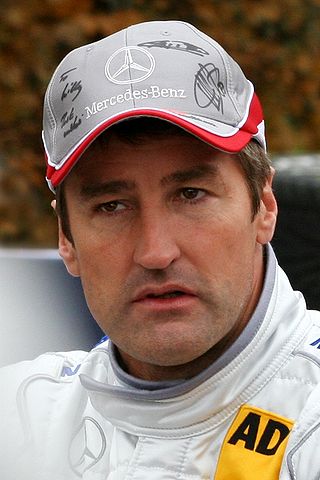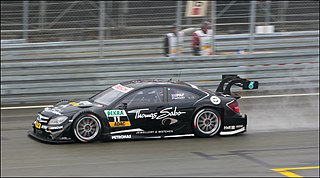The DTM is a sports car racing series sanctioned by ADAC. The series is based in Germany, with rounds elsewhere in Europe. In its first years the official name of the "new DTM" was Deutsche Tourenwagen Masters, but since 2005 all official documents only call it DTM. The series currently races a modified version of Group GT3 grand touring cars, replacing the silhouette later Class 1 touring cars of earlier years.

The Mercedes-Benz CLK-Class is a former series of mid-size or entry-level luxury coupés and convertibles produced by Mercedes-Benz between 1996 and 2010. Although its design and styling was derived from the E-Class, the mechanical underpinnings were based on the smaller C-Class, and was positioned between the Mercedes-Benz SLK-Class and CL-Class. The name CLK is either derived from the German words "Coupé", "Luxus" (luxury) and "Kurz" (short) or "Coupé", "Leicht" (light) and "Kurz" (short), as the clear definition was never published. It primarily competes with the two-door BMW 3 and 6 Series, as well as the Audi A4 Cabriolet and Audi A5 Coupe/Cabriolet, as well as the Maserati Coupe and its convertible variant.

The Mercedes-Benz M112 engine is a gasoline-fueled, 4-stroke, spark-ignition, internal-combustion automobile piston V6 engine family used in the 2000s. Introduced in 1996, it was the first gasoline V6 engine ever built by Mercedes. A short time later the related M113 V8 was introduced.

The Mercedes-Benz M113 engine is a gasoline-fueled, spark-ignition internal-combustion V8 automobile engine family used in the 2000s. It is based on the similar M112 V6 introduced in 1997, then later phased out in 2007 for the M156 AMG engine and the M273 engine.

The C209/A209 Mercedes-Benz CLK-Class is the second generation of the Mercedes-Benz CLK-Class range of grand tourers, produced between 2001 and 2009. There were two body styles available: a 2-door coupé (C209) and a 2-door convertible (A209). The latter being assembled at the Karmann plant in Osnabrück. It was also the last complete car made by Karmann before closing the facility.

Bernd Robert Schneider is a German racing driver. He is a five-time Deutsche Tourenwagen Masters champion, and a Mercedes Brand Ambassador.

The C208/A208 Mercedes-Benz CLK-Class was introduced in 1997, and was based on the W202 Mercedes-Benz C-Class launched three years earlier. The C208 coupé was the first generation of the Mercedes-Benz CLK-Class and was subsequently replaced by the C209 CLK-Class in 2002, although the convertible remained in production till March 2003 when replaced by the A209 CLK. In total 233,367 units of the first generation CLK were manufactured in its coupé form, when production ceased in May 2002 and additional 115,161 cabriolets assembled at Karmann plant in Osnabrück.

The Mercedes-Benz CLK GTR is a GT1 sports car built and produced by Mercedes-Benz in conjunction with their then motorsport partner AMG. Intended for racing in the new FIA GT Championship series in 1997, the CLK GTR was designed primarily as a race car. As such, the production of road cars necessary in order to meet homologation standards of GT1 was a secondary consideration in the car's design, i.e. the CLK GTR was a homologation special.

The Mercedes-Benz CLK LM was a Group GT1 sports car designed and built by Mercedes-Benz in partnership with AMG to compete in the FIA GT Championship. To satisfy the requirements of competing in the FIA GT Championship, a road-legal version had to be built to homologate the car. That car was known as the Mercedes-Benz CLK LM Straßenversion, and Mercedes-Benz assembled two chassis, one of which was destroyed for crash-testing. The CLK LM went on to win every single championship event in the 1998 FIA GT season, retiring only at the 1998 24 Hours of Le Mans, which was a non-championship event. The removal of the GT1 class from the FIA GT Championship due to the lack of entrants and rising costs meant that Mercedes' GT1 program was brought to a close at the end of 1998. Mercedes instead focussed their efforts on the newly introduced LMGTP class for the 1999 season, which produced the Mercedes-Benz CLR.

The 2003 Deutsche Tourenwagen Masters was the seventeenth season of premier German touring car championship and also fourth season under the moniker of Deutsche Tourenwagen Masters since the series' resumption in 2000. Unlike 2002 there were ten race weekends with only one race at each event.
Throughout its long history, Mercedes-Benz has been involved in a range of successful motorsport activities, including sportscar racing, touring car racing, Grand Prix racing, and rallying. It is currently active in GT racing, and Formula One. Mercedes is also one of only three constructors to complete the Triple Crown of Motorsport, a feat that Mercedes achieved as both a chassis manufacturer and an engine manufacturer by winning the 1952 24 Hours of Le Mans.
5G-Tronic is Mercedes-Benz's trademark name for its five-speed automatic transmission, starting off with the W5A 580 and W5A 330 as core models.
The 1996 International Touring Car Championship was the thirteenth season of premier German touring car championship and also only first and final season under the moniker of International Touring Car Championship. It was for FIA Class 1 Touring Cars and it was contested by Mercedes-Benz, Alfa Romeo and Opel. It was formed of the Deutsche Tourenwagen Meisterschaft series that ran both a short German & International-based series in 1995. These were fused together to form the International Touring Car Championship. The eventual champion was Manuel Reuter driving an Opel Calibra, and Opel won the manufacturer's championship.

The 2009 Deutsche Tourenwagen Masters was the twenty-third season of premier German touring car championship and also tenth season under the moniker of Deutsche Tourenwagen Masters since the series' resumption in 2000. The series began on 17 May at Hockenheim and finished on 25 October at the same venue.

Persson Motorsport was an auto racing team based in Germany. Managed by Ingmar Persson, they have competed in the Deutsche Tourenwagen Masters since their formation in 1993 until 2012, running privateer Mercedes.
HWA Team, also known as HWA RACELAB, is the auto racing team of HWA AG, a German company based in Affalterbach, that also develops and builds vehicles and components for Mercedes-AMG race cars. It is named after founder Hans-Werner Aufrecht.

Kompressor is a marketing name for forced induction (supercharged) Mercedes-Benz engines. The term is not widely used by other motor manufacturers.

The Mercedes-AMG C-Coupé DTM is a silhouette racing car designed by Mercedes-Benz for the Deutsche Tourenwagen Masters championship. Mercedes-Benz chose the IAA International Motor Show in Frankfurt to present the new 2012 DTM AMG Mercedes C-Coupé. It is the successor to the AMG-Mercedes C-Klasse race car which was permanently retired after the 2011 season. Since 2015 the car has been renamed Mercedes-AMG C63 DTM. The C-Coupé DTM was initially based on the C204 Mercedes-Benz C-Coupé; for the 2016 season it was updated to reflect the new C205 Mercedes-Benz C-Coupé body style.

The Mercedes-Benz AMG C-Class W203 DTM is a DTM touring car constructed by the German car manufacturer Mercedes-Benz. It was the successor to the Mercedes-Benz CLK DTM which was permanently retired after the 2003 season, and based on the Mercedes-Benz C-Class W203 first generation car. Mercedes-Benz AMG C-Class W203 DTM made its first appearance on 3 February 2004 at the Circuit de Catalunya.
The Mercedes-Benz DTM V8 engine is a prototype, four-stroke, 4.0-liter, naturally aspirated V-8 racing engines, developed and produced by Mercedes-Benz for the Deutsche Tourenwagen Masters, between 2000 and 2018.





















